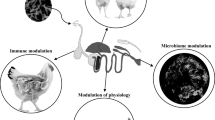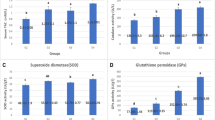Abstract
Spirulina has been used as human food supplement for over 20 years, but its use as an animal feed supplement is relatively recent. This paper reviews earlier studies on its more established effects on growth, survival and tissue quality in a whole range of animals and more recent studies on its immunomodulatory, anti-viral and anti-cancer effects. The basis for potential application as an animal feed supplement is discussed.
Similar content being viewed by others
References
Anderson D, Tang C, Ross E (1991) The xanthophylls ofSpirulina and their effect on egg yolk pigmentation. Poultry Science 70: 115–119.
Ayehunie S, Belay A, Hu Y, Baba TN, Ruprecht R (1996) Inhibition of HIV-1 replication by an aqueous extract ofSpirulina platensis (Arthrospira platensis). Abstract. 7th International Conference, International Association of Applied Algology, South Africa, 16–19 April 1996. J. appl. Phycol. 8: 440.
Ayyappan S (1992) Potential ofSpirulina as a feed supplement for carp fry. Seshadri CV, Jeeji Bai N (eds)Spirulina Ecology, Taxonomy, Technology, and Applications. National Symposium, Murugappa Chettiar Research Centre, Madras, 171–172.
Baojiang G. (1994) Study on effect and mechanism of polysaccharides ofSpirulina platensis on body immune functions improvement. Book of Abstracts. Second Asia-Pacific Conference on Algal Biotechnology, p. 24.
Becker EW, Venkataraman LV (1982) Biotechnology and Exploitation of Algae: The Indian Approach. German Agency for Technical Cooperation, Eschborn, West Germany.
Belay A, Ota Y, Miyakawa K, Shimamatsu H (1993) Current knowledge on potential health benefits ofSpirulina. J. appl. Phycol. 5: 235–241.
Besednova NN, Smolins TP, Michciskaya LB, Ovodova PG (1979) Immunostimulating activity of lipopolysaccharides in blue-green algae. Zhurnal Mikrobiologii, Epidemiologii, Immunobiologii 56: 75–79. (in Russian)
Blum JC, Calet C (1976) Valeur alimentaire des algues spirulines pour la croissance du poulet de chair. Ann. Nutr. Aliment. 29: 551–574.
Blum JC, Guillaumin S, Calet C (1976) Valeur alimentaire des algues spirulines pour la poule pondeuse. Ann. Nutr. Aliment. 29: 675–682.
Brune H (1982) Zur Vertraglichkeit der EinzelleralgenSpirulina maxima undScenedesmus acutus als alleinige Eiweibquelle fur Broiler. Z. Tierphysiol. Tieremachr. Futtermittelkd. 48: 143–154.
Chow CY, Woo NYS (1990) Bioenergetic studies on an omnivorous fishOreochromis mossambicus: evaluation of the utilization ofSpirulina algae in feeds. In Hiranu R, Hanyu I (eds), Proc. 2nd Asian Fish. Forum, Tokyo, Japan, 291–294.
Ciferri O, Tiboni O (1985) The biochemistry and industrial potential ofSpirulina. Ann. Rev. Microbiol. 39: 503–526.
Colas B, Sauvageot F, Harscoat JP, Sauveur B (1979) Proteines alimentaires et qualité de l'oeuf. II. Influence de la nature des proteines distribuées aux poules sur les caracteristiques sensorielles de l'oeuf et la teneur en acides amines libres du jaune. Ann. Zootech. (Paris) 28: 297–314.
Daniel T, Kumuthakalavalli R (1991) The use ofSpirulina, a blue-green alga, as a substitute for fish meal in diets forCirrhinus mrigana fingerlings. Indian Zoologist 15: 5–7.
Daniel T, Kumuthakalavalli R. (1992) Evaluation of the suitability ofSpirulina algae in the feed of silver carp, Hypophthalmichthys molitrix (Valenciennes) fingerlings. Seshadri CV, Jeeji Bai, N (eds)Spirulina Ecology, Taxonomy, Technology, and Applications, National Symposium, Murugappa Chettiar Research Centre Madras, 167–170.
El-Sayed AM (1994) Evaluation of soybean meal,Spirulina meal and chicken offal meal as protein sources for silver seabream (Rhabdosargus sarba) fingerlings. Aquaculture 127: 169–176.
Feinstein GR, Buck EM (1984) Relationship of texture to pH and collagen content of yellowtail flounder cusk. J. Food Sci. 49: 298–299.
Fukino H, Takagi Y, Yamane Y (1990) Effect ofSpirulina (S. platensis) on the renal toxicity induced by inorganic mercury and cisplatin. Eisei Kagaku 36: 5. (in Japanese)
Hayashi K, Hayashi T, Morita N (1993) An extract fromSpirulina platensis is a selective inhibitor ofHerpes simplex virus type 1 penetration into Hela cells. Phytotherapy Research 7: 76–80.
Hayashi K, Kato T., Okuwaki Y (1994) Enhancement of antibody production in mice by dietarySpirulina. J. Nutr. Sci. Vitaminol. 40: 431–441.
Hayashi T, Hyashi K, Maeda M, Kojima I (1996) Calcium spirulan, an inhibitor of enveloped virus replication, from a blue-green algaSpirulina platensis. J. Nat. Prod. 59: 83–87.
Kato T, Saiki I, Hayashi T (1995) An agent to restrict tumor metastasis. Japanese Patent, Application # TOKU-GAN-HEI-07-338784.
Kato T, Miyakawa K (1992) Growth promotion agent for fish. Japanese Patent # TOKU-KAI-HEI 5-268884.
Kato T, Takemoto K, Katayama H, Kuwabara Y (1984) Effects ofSpirulina (Spirulina platensis) on dietary hypercholesterolemia in rats. J. Jap. Soc. Nutr. food Sci. 37: 323–332. (in Japanese).
Liao W, Nur-E-Borhan SA, Okada S, Matsui T, Yamaguchi K (1993) Pigmentation of cultured black tiger prawn by feeding withSpirulina-supplemented diet. Nippon Suisan Gakkaishi 59: 165–169.
Liao W, Takeuchi T, Watanabe T, Yamaguchi K (1990) Effect of dietarySpirulina supplementation on extractive nitrogenous constituents and sensory test of cultured striped jack flesh. Journal of the Tokyo University of Fisheries 77: 241–246. (in Japanese)
Mathew B, Sankaranarayanan R, Nair PP, Varghese C, Somanathan T, Amma BP, Amma NS, Nair MK (1995) Evaluation of chemoprevention of oral cancer withSpirulina fusiformis. Nutr. Cancer 24: 197–202.
Matsuno T, Katsuyama M, Iwahashi M, Koike T, Okada M (1980) Intensification of color of redTilapia with lutein, rhodoxanthin andSpirulina. Bull. Jap. Soc. Sci. Fisheries 46: 479–482. (in Japanese).
Matsuno T, Ngata S, Iwahashi M, Koike T, Okada M (1979) Intensification of color of fancy red carp with zeaxanthin and myxoxanthophyll, major carotenoid constituents ofSpirulina. Bulletin of the Japanese Society of Scientific Fisheries 45: 627–632. (in Japanese).
Mori T, Muranaka T, Miki W, Yamaguchi K, Konosu S, Watanabe T (1987) Pigmentation of cultured sweet smelt fed diets supplemented with a blue-green algaSpirulina maxima. Nippon Suisan Gakkaishi 53: 433–438.
Mustafa MG, Takeda T, Umino T, Wakamatsu S, Nakagawa H (1994a) Effect ofAscophyllum andSpirulina meal as feed additives on growth and feed utilization of red sea bream, Pagrus major. J. Fac. appl. Sci. Hiroshima Univ. 33: 125–132.
Mustafa MG, Umino T, Miyake H, Nakagawa H (1994b) Effect ofSpirulina sp. meal as feed additive on lipid accumulation in red sea bream. Suisanzoshoku 42: 363–369.
Mustafa MG, Umino T, Nakagawa H (1994c) The effect ofSpirulina feeding on muscle protein deposition in red sea bream,Pagrus major. J. appl. Ichthyol. 10: 141–145.
Nagao K, Takai Y, Ono M (1991) Exercises of growing mice, and the effect of the intake ofSpirulina platensis upon the hapten-specific immune response. Sci. Phys. Power 40: 187–194.
Nakagawa H, Gomez-Diaz G (1995) Usefulness ofSpirulina sp. meal as feed additive for giant freshwater prawn,Mcrobrachium rosenbergii. Suisanzoshoku 43: 521-Naka526.
Nakaya N, Honma Y, Goto Y (1988) Cholesterol lowering effect ofSpirulina. Nutr. Rep. Int. 37: 1329–1337.
Nazarenko R, Kuchkarova M, Lavrov A, Tulaganov A, Zaripov E (1975) Study of the effect of the suspended matter of the algaSpirulina platensis on egg production and live weight of chickens (feed supplement). Uzb. Biol. Zh 19: 21–23.
Okada S, Liao W, Mori T, Yamaguchi T, Watanabe T (1991) Pigmentation of cultured striped jack reared on diets supplemented with the blue-green algaSpirulina maxima. Nippon Suisan Gakkaishi 57: 1403–1406.
Qishen P, Baojiang G, Jihong R (1988) Enhancement of endonuclease activity and repair DNA synthesis by polysaccharides ofSpirulina platensis. (in Chinese) Acta Genetica Sinica 15: 374–381.
Qishen P, Coleman A, Baojiang G (1989) Radioprotective effect of extract fromSpirulina platensis in mouse bone marrow cells studied by using the micronucleus test. Toxicology Lett. 48: 165–169.
Qureshi MA (1996)Spirulina platensis exposures enhances macrophage phagocytic function in cats. Immunopharmacology and Immunotoxicology 18: 457–463.
Qureshi MA, Ali RA, Hunter RL (1995a) Immunomodulatory effects ofSpirulina platensis supplementation in chickens. Proc. 44th West. Poultry Dis. Conf. Sacramento, California, 117–121.
Qureshi MA, Garlich D, Kidd MT, Ali RA (1994) Immune enhancement potential ofSpirulina platensis in chickens. Poultry Sci. 73: 46.
Qureshi MA, Kidd MT, Ali RA (1995b)Spirulina platensis extract enhances chicken macrophage functions afterin vitro exposure, J. Nut. Immunol. 4 (in press).
Ross E, Dominy W (1990) The nutritional value of dehydrated, bluegreen algae (Spirulina platensis) for poultry. Poultry Science 69: 794–800.
Sakakibara M, Hamada S (1994) Lowering agent of death rate of young quail. Japanese Patent # 200664.
Santiago CB, Pantastico JB, Baldia SF, Reyes OS (1989) Milkfish (Chanos chanos) fingerling production in freshwater ponds with the use of natural and artificial feeds. Aquaculture 77: 307–318.
Sato K, Yoshinaka R, Sato M, Simizu Y (1986) Collagen content in the muscle of fishes in association with their swimming movement and meat texture. Nippn Suisan Gakkaishi 52: 1595–1600.
Sauveur B, Zybko A, Colas B (1979) Dietary protein and egg quality. I. Effects of some protein source on egg quality and functional properties. Ann. Zootech. (Paris) 28: 271–295.
Schwartz JL, Shklar G (1987) Regression of experimental hamster cancer by beta-carotene and algae extracts. J. oral maxillorfac. Surg. 45: 510–515.
Schwartz JL, Shklar G, Reid S, Trickler D (1988) Prevention of experimental oral cancer by extracts ofSpirulina-Dunaliella algae. Nutr. Cancer 11: 127–134.
Stanley JG, Jones JB (1976) Feeding algae to fish. Aquaculture 7: 219–223.
Watanabe T, Liao W, Takeuchi T, Yamamoto H (1990) Effect of dietarySpirulina supplementation on growth performance and flesh lipids of cultured striped jack. J. Tokyo Univ. Fish. 77: 231–239. (in Japanese).
Yap TN, Wu JF, Pond WG, Krook L (1982) Feasibility of feedingSpirulina maxima, Arthrospira platensis orChlorella sp. to pigs weaned to a dry diet at 4 to 8 days of age. Nutritional Reports International 25: 543–552.
Yoshida M, Hoshii H (1980) Nutritive value ofSpirulina, green algae, for poultry feed. Jpn. Poult. Sci. 17: 27–30.
Zhang CW, Tseng CT, Zhang YZ (1994) The effects of polysaccharides and phycocyanin fromSpirulina platensis var. on peripheral blood and hematopoietic system of bone marrow in mice. 2nd Asia-Pacific Conference on Algal Biotechnology. Book of Abstracts, p. 58.
Zhang YZ, Zhang CW, Tseng CT (1995) Using the extract material forSpirulina platensis var.nanjingesis to treat on the anemia disease. 13th International Symposium on Cyanophyte Research. Book of Abstracts, p. 106.
Author information
Authors and Affiliations
Rights and permissions
About this article
Cite this article
Belay, A., Kato, T. & Ota, Y. Spirulina (Arthrospira): potential application as an animal feed supplement. J Appl Phycol 8, 303–311 (1996). https://doi.org/10.1007/BF02178573
Received:
Revised:
Accepted:
Issue Date:
DOI: https://doi.org/10.1007/BF02178573




